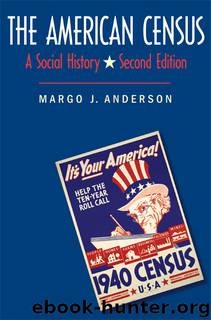The American Census by Margo J. Anderson

Author:Margo J. Anderson
Language: eng
Format: epub
ISBN: 9780300216967
Publisher: Yale University Press
The patriotic images of the “Ten-Year Roll Call” are evident in this 1940 publicity poster. (Library of Congress)
Through 1938 and into 1939, therefore, the statisticians discussed how to fit new questions onto the schedule, how to word such questions, and whether the questions would provide the information needed. As the discussions continued, the statisticians separated what became the housing census questions from the population census. In August 1939, Congress passed legislation authorizing a census of housing. The new schedule, administered simultaneously with the population schedule, asked questions on the value, condition, and rent or mortgage of all occupied dwellings. It also had questions on water supplies, bathroom facilities, lighting, heating, and appliances. For the first time, the federal government would collect data to provide a full picture of the nation’s housing stock.42
For the population schedule, the officials agreed to add questions on income, migration, fertility, educational attainment, social security status, and usual occupation. They also agreed to put the unemployment inquiry on the main schedule. This added seven questions to the schedule. It became increasingly clear that it would not be possible to include these new inquiries without deleting some of the old ones. The chief candidates for removal were those dealing with mother tongue, place of parents’ birth, and veterans’ status. Yet many statisticians—within and outside government—wanted this information so that historical comparisons could be made with past censuses. The young New Deal statisticians thus lobbied their older colleagues to accept a sample census along with the complete count. The questions crowded off the main schedule could be asked on a sample basis. More data could be collected without greatly increased additional costs, and the sample results could be tabulated quickly for summary public presentations. Some old-timers in the bureau were dubious about such claims, but they were willing to be convinced by the Dedricks and Hansens and Stephans of the younger generation.
The 1940 census took a major step in statistical method by including “supplementary questions,” as they were euphemistically called, for two people on each side of the forty-line population schedule. The questions on parents’ birthplace, mother tongue, veterans’ status, usual occupation, social security status, and fertility were asked on the sample schedule. The bureau hired a number of new statisticians. Among the most prominent were Philip Hauser, the assistant chief statistician for population, W. Edwards Deming, sampling expert in the Population Division, and William Hurwitz in the Statistical Research Division. These men supported the work begun by Stuart Rice, Calvert Dedrick, and Morris Hansen in the mid-1930s.
As planning continued, the statisticians struggled with a number of thorny technical issues. They had to define the sample; they had to perfect the wording of the new questions. None of these problems was easy, but the statisticians drew from their now rather broad experience with population surveys in the previous ten years. A new conception of occupational status—the labor force concept—replaced that of the gainful worker to improve the measurement of unemployment. Workers were first asked if they were working or looking for work the week the census was taken.
Download
This site does not store any files on its server. We only index and link to content provided by other sites. Please contact the content providers to delete copyright contents if any and email us, we'll remove relevant links or contents immediately.
| Biomathematics | Differential Equations |
| Game Theory | Graph Theory |
| Linear Programming | Probability & Statistics |
| Statistics | Stochastic Modeling |
| Vector Analysis |
Weapons of Math Destruction by Cathy O'Neil(5036)
Factfulness: Ten Reasons We're Wrong About the World – and Why Things Are Better Than You Think by Hans Rosling(4021)
Factfulness_Ten Reasons We're Wrong About the World_and Why Things Are Better Than You Think by Hans Rosling(2754)
Descartes' Error by Antonio Damasio(2731)
A Mind For Numbers: How to Excel at Math and Science (Even If You Flunked Algebra) by Barbara Oakley(2691)
TCP IP by Todd Lammle(2638)
Applied Predictive Modeling by Max Kuhn & Kjell Johnson(2478)
Fooled by Randomness: The Hidden Role of Chance in Life and in the Markets by Nassim Nicholas Taleb(2412)
The Book of Numbers by Peter Bentley(2403)
The Tyranny of Metrics by Jerry Z. Muller(2401)
The Great Unknown by Marcus du Sautoy(2185)
Once Upon an Algorithm by Martin Erwig(2148)
Easy Algebra Step-by-Step by Sandra Luna McCune(2117)
Practical Guide To Principal Component Methods in R (Multivariate Analysis Book 2) by Alboukadel Kassambara(2092)
Lady Luck by Kristen Ashley(2071)
Police Exams Prep 2018-2019 by Kaplan Test Prep(2032)
Linear Time-Invariant Systems, Behaviors and Modules by Ulrich Oberst & Martin Scheicher & Ingrid Scheicher(1982)
All Things Reconsidered by Bill Thompson III(1960)
Secrets of Creation, Volume 1: The Mystery of the Prime Numbers by Watkins Matthew(1864)
